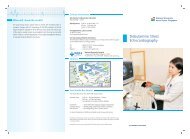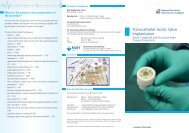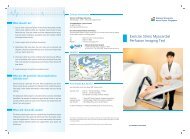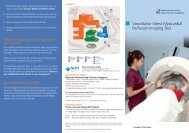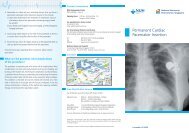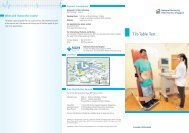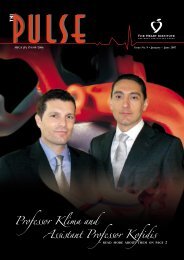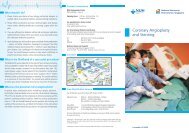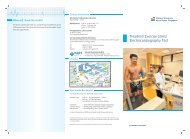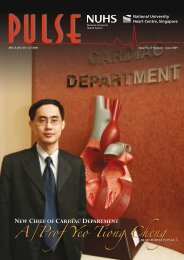2011 July - December - nuhcs
2011 July - December - nuhcs
2011 July - December - nuhcs
- No tags were found...
Create successful ePaper yourself
Turn your PDF publications into a flip-book with our unique Google optimized e-Paper software.
What isOptical CoherenceTomography?A/Prof Ronald LeeSince its inception 25 years ago,percutaneous coronary intervention (PCI)has gained widespread acceptance, andcoronary stent implantation has become thestandard revascularization therapy for mostpatients with obstructive coronary arterydisease. Yet, instent restenosis and stentthrombosis are two major complicationslimiting the benefits of PCI. Although the emergence of drug-elutingstents has remarkably reduced the occurrence of instent restenosis,stent thrombosis—which is associated with high incidences of fataland non-fatal myocardial infarction—remains an unsolved problem.In fact, late stent thrombosis occurs more frequently following drugelutingstent than bare metal stent implantation. Moreover, the useof drug-eluting stents in increasingly complex lesions and multivesselcoronary artery disease implies that these complications are likely topersist and effective preventive strategy is warranted.Stand-alone X-ray angiography is the traditional imaging methodguiding PCI, and is still used in majority of the procedures nowadays.Coronary angiography depicts vessel images that are relatively simpleto comprehend, making PCI procedures easy to perform. However,stand-alone angiographic guidance has some inherent inadequacies andlimitations, which, if one fails to recognize, may result in suboptimalprocedural outcomes, as well as acute and long-term complications.Among others, angiography merely produces a planar silhouette ofthe contrast-filled lumen. The severity of the lesion can vary widelywith different X-ray projection angles. In fact, visual interpretationof angiography exhibits significant inter-observer variability andcorrelates poorly with post-mortem examination. In addition, coronaryangiography is essentially a luminography, which provides no insightto the amount, tissue composition, distribution of coronary plaque, aswell as coronary remodeling pattern. After coronary stent implantation,angiography has limited ability to assess the adequacy of stent expansionand stent strut apposition. Therefore, intravascular imaging technologyhas been widely accepted as an essential tool in complex PCI.Until recently, intravascular ultrasound (IVUS) is the onlyintravascular imaging technology available. There are severalpotential utilizations of IVUS when a coronary stenosis is detectedby angiography. As a baseline evaluation tool, IVUS providesquantitative measurement on the extent of artery lumen obstruction,enabling the operator to determine if the patient would benefitfrom revascularization therapy. Once committed for PCI, IVUSalso assists in procedural strategy and device selection. In a singlecenter study, the original revascularization strategy planned waschanged after preintervention IVUSimaging of the target lesions. Followingstent implantation, IVUS plays a crucialrole in optimizing the procedural outcomes,which in turn determines the risk of futurecomplications. IVUS optimizes outcomesthrough assessment on adequacy of stentexpansion, completeness of stent strutapposition and presence of unrecognized dissection or residual stenosis.Optical Coherence Tomography (OCT) has emerged as theintravascular imaging technology. OCT is an imaging modality thatis analogous to ultrasound imaging, but uses light instead of sound.Cross-sectional images are generated by measuring the echo timedelay and intensity of light that is reflected or back-scattered frominternal structures in tissue. Preliminary experiences with OCT imagesacquisition show the technique to be safe. OCT imaging techniquehas gained considerable adoption in many centres across Europe andJapan, and various centres have presented large series of patients imagedby OCT without major complications. Compared with conventionalIVUS, OCT offers several advantages. The resolution of OCT (10 μm)is 10 times better than that of IVUS (100-150 μm). This enables thedetection of procedural complications such as stent edge dissectionwith higher accuracy. In addition, tissue coverage of the drug-elutingstent struts, which has been proposed as a parameter predicting latestent thrombosis, can be assessed reliably by OCT. Acquisition of theimages by OCT is much faster than that of IVUS (20 seconds versus2-3 minutes). Last but not least, OCT is the only technology whichcan accurately measure coronary plaque fibrous cap thickness, whichis one of the most important characteristics underlying a vulnerableplaque. With all these advancements, OCT is perceived to the overtakeIVUS as the predominant intravascular imaging technology in moderncardiac catheterization laboratory.In order for the interventional cardiology team to acquire thenecessary skills and knowledge in this new technology, we weregranted the Academic Medicine Development Award (AMDA) forshort-term training in 2 overseas centers. I have spent four weeksat the Massachusetts General Hospital, Harvard Medical Schoolunder Professor IK Jang. Mr. Anand Kalesam and Miss JY Lee(medical technologists) have each spent 2 weeks at the Thoraxcenter,The Netherlands under Dr. Everlyn Regar. Our OCT program hasstarted since 4 months ago and a few cases of OCT imaging procedureshave been performed. It is anticipated that OCT will becomethe intravascular imaging technology of choice in our catheterizationlaboratory.NUHCS PULSE | 9



